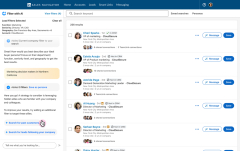The 3 Key Decisions To Webcast Series Success
- Written by Brian Anderson
- Published in Blog
 Webcast series have become popular in the marketplace, aiming to provide a “binge-worthy” content option for target audiences while offering a different format that is more engaging and valuable. We here at Demand Gen Report, as well as all our brands under the G3 Communications umbrella, believe that the key to a successful webcast series lies in first defining production and promotion processes that are scalable, repeatable and flexible.
Webcast series have become popular in the marketplace, aiming to provide a “binge-worthy” content option for target audiences while offering a different format that is more engaging and valuable. We here at Demand Gen Report, as well as all our brands under the G3 Communications umbrella, believe that the key to a successful webcast series lies in first defining production and promotion processes that are scalable, repeatable and flexible.
One of the most popular people in our office, Sheri Butts, Marketing Manager at G3 Communications, had a lot to say on this topic at her recent session at Webinar World 2019. She offered a detailed checklist for teams looking to build out a webcast series. During the first part of her session, she highlighted the three main decisions webcast producers must make to get a program off the ground:
1) Decide The Theme
Like with any content strategy, understanding and building a plan around a particular theme is vital to brand consistency and ensuring the main messages and takeaways that want to be addressed are the highlight of the webcast series.
According to Butts, the main theme is what drives the entirety of the webcast series’ production schedule. “The theme is going to not only help you determine a cadence for your sessions, but also what some of those sessions are going to look like — what format you will use, who can tell that story, what content will support it,” Butts noted during her session.
2) Decide The Format
Butts shared three specific format types being leveraged throughout the industry, while also highlighting how they can be beneficial to an aspiring producer:
- The “Mini Series.” This is essentially a blitz of webcasts within a relatively short period of time. In the case of G3 Communications, its series are week-long events that host anywhere from one to three webcasts per day, for five days straight. “This model works because the theme of our series is pretty time specific,” Butts added. “For example, we have our annual Strategy & Planning Series that takes place at the end of October into early November. It centers around the ways marketers can assess their programs from the year that's gone by and think about what they might need to tweak or change for the year ahead.”
- The “Episodic Series.” This is the most common format that we're all accustomed to when we think of a series of any kind — such as TV talk shows or podcasts. “For example, LinkedIn started a webcast series called “Live With Marketers," and their main motivation was that they wanted to break away from the standard talking over slides format and create a more personal experience,” Butts said. “So, they began a morning talk show by marketers for marketers to help humanize their brand. An episodic approach can help you build a sustained brand presence. It can also extend the life of your theme and continue to bring it back top of mind, since you can host quarterly, monthly or weekly episodes.”
- The “Virtual Event.” This is when you aim to simulate a live event, in which the webcasts are positioned more like sessions of a live event. “You might want to consider this type of series if your topic is very targeted, or if you are encouraging completion of all the sessions for some reason,” Butts added. “For example, a certification course, or an online class might benefit from this format.”
3) Decide The Session Topics And Speakers
Session topics and speakers should tie back to the main theme, as well as support your format of choice. Butts shared some suggested sources for identifying potential speakers:
- Clients, who can fuel case studies or panel discussions;
- Analysts/Experts, who can provide detailed research and industry trends;
- Influencers, who can offer expertise and perspective; and
- Partners, who may share a common interest, goal and/or following.
“For example, our Buyer Insights & Intelligence Series happens around the same time [Demand Gen Report] publishes its B2B Buyers Survey Report,” Butts noted. “We use this report to kick off the series; we start the series with a session that focuses on the findings of that report, we dive deeper into it, we examine it, we talk about what it might mean for revenue teams. And then throughout the series, we have various speakers from all different areas of expertise, leading back to that same report. They might be talking from a completely different angle, but each one will reference that report and explore how it's affecting their role, their organization, their discipline.”
Of course, developing a good theme is just the very beginning. To help guide fellow webinerds through the comprehensive process, Butts shared an awesome checklist that dives into the nitty gritty of kicking off a series, planning out promotion, rehearsal and production, tactics for when the series is live, post-series follow-up, as well as ongoing measurement of campaign success.
And speaking of webcasts, you can catch one of Demand Gen Report’s series in action this month, by signing up for the Campaign Optimization Series: What’s Working In B2B Marketing, which will take place April 22-26.
What intrigues you the most about webinar series? Leave a comment below to let us know what your favorite webcast tips and tools look like.

Brian Anderson
An avid B2B journalist with a knack for all things trendy in the POS, mobile and social space.
Related items
-
 LinkedIn Releases AI-Assisted Intelligence Features
LinkedIn Releases AI-Assisted Intelligence Features
-
 LinkedIn Introduces Sales Navigator AI-Assisted Search & Account IQ
LinkedIn Introduces Sales Navigator AI-Assisted Search & Account IQ
-
 Future-Proofing B2B Marketing: Key Strategies For 2024 Planning Success
Future-Proofing B2B Marketing: Key Strategies For 2024 Planning Success
-
 Lights, Camera, Conversion: The 4 Uses Of A/V Content Across The Buyer’s Journey
Lights, Camera, Conversion: The 4 Uses Of A/V Content Across The Buyer’s Journey
-
 FanHero Studio Aims To Help Creators Deliver Customized, Professional-Grade Live Streams
FanHero Studio Aims To Help Creators Deliver Customized, Professional-Grade Live Streams


